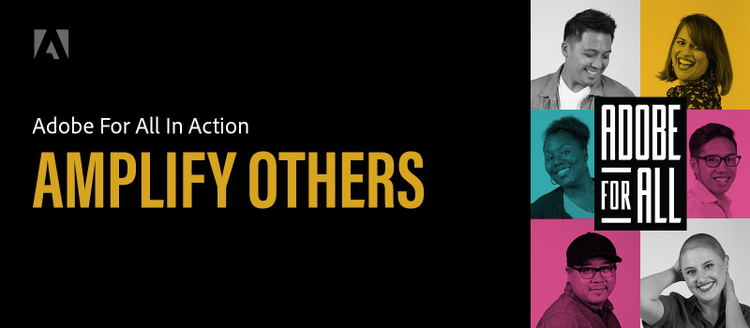Amplify Others
Adobe For All in Action.

Last week, we kicked off a blog series on the cornerstone of our approach to building a workplace where everyone feels included, respected, and valued. We call this Adobe For All in Action. But it isn’t limited to Adobe! It can equally be applied to any company and team environment.
Adobe For All in Action includes five simple elements:
- Appreciate the Unique: Value the differences in others’ stories and ideas.
- Amplify Others: Help everyone’s voice be heard.
- Enhance the Team: Consider what a new addition will bring that’s different.
- Rethink Routine: Look to equalize meetings, assignments, social events.
- Open Up: Speak up for what you need, and encourage feedback.
Our focus for this post: Amplify Others.
A high-performing team relies on everyone’s ideas and knowledge being fully harnessed. But in most group meetings, that doesn’t happen. Someone gets interrupted and talked over. Another never quite finds an opening to contribute. A third watches a colleague claim credit for their idea. We’ve all seen these scenes play out… sometimes to us.
Meeting dynamics are complex, but in broad strokes, the root issues for disparity fall into three dimensions:
1. Different processing styles (extrovert vs. introvert)
Great work has been done on the differences between extroverts and introverts, relative to how they process information. In the meeting context, there is no question that extroverts are at an advantage: They are comfortable “talking through” the information and throwing out ideas. They might interrupt and add on to others’ comments, out of sheer enthusiasm for the participation and ideation. The introvert — who often wants to be thoughtful and well-prepared before making any remarks — gets left off to the side as the rampaging extroverts keep the floor. (Full disclosure, I am one of those extroverts myself. It can be a menace, despite my best intentions.)
To level the playing field, here are some things I try to do for my meetings — especially larger meetings where some participants may feel less comfortable:
- Publish the meeting agenda and goals in advance.
- Share any background (especially data or examples) as far ahead as possible as a pre-read.
- At the start of the meeting, make it clear that I want to hear everyone’s perspectives (giving a heads-up so people know they should contribute).
- Proactively call upon anyone who hasn’t spoken without putting them on the spot (e.g., “Chris, do you have anything you want to add?” versus “Chris, what do you think?”).
2. Remote vs. in-person
For those of us who work for large, global companies, dispersed meeting participants are a daily reality.
This hilarious video captures some of the worst challenges. Video technology helps – at least we can see someone’s non-verbal cues – but lag and sound issues can still make it challenging. (Interestingly, the video has the only female participant assigned to send out meeting notes. We’ll get to that issue in Rethink Routine, coming in a future post.)
It can be especially hard for people who are remote when most of the meeting participants are in person. The in-room chatter is hard to decipher, and jumping into the conversation takes a lot of bravery when you can’t see everyone’s face. On top of that, you may be joining at a difficult time of day. I admire my colleagues in India who regularly join our U.S. calls, late at night their time, after they have already had a long work day. It can’t be easy to contribute with enthusiastic and fresh ideas!
Until technology reaches some kind of perfect solution for this, we really just need to be sensitive and inclusive — proactively including everyone in the conversation and making sure that in-person folks are helping the remote ones follow along. Try experimenting with alternating time zones, or virtual-only meetings, to see if that makes a positive impact.
3. Power dynamics
In my view, the hardest aspect to fully control is the power dynamics between individuals in the meeting. These dynamics can be obvious — e.g., one person is more senior than others — or more subtle, such as gender, age, or ethnicity.
There is a fascinating piece about this in Harvard Business Review. It’s a bit long and vintage relative to publish date, but it’s worth reading. It dives into the power dynamics of linguistics in a way that I have never seen spelled out this clearly. The bottom line is that individuals with lower status — or who have been culturally trained to be more consensus-oriented — are less likely to be heard.
There are lots of great tips about asserting oneself more effectively in meetings. But it’s really up to all of us — especially people on the higher end of the power scale — to make space for everyone’s voice be heard through awareness, careful listening, and occasional intervention.
Like all of our Adobe For All in Action steps, amplifying others can be done by anyone. It’s especially critical for senior leaders and meeting owners, but anyone can praise a colleague’s idea or make sure that they are given an opening to add to the conversation. Those small things can make a huge difference.
Stay tuned for future segments in our Adobe For All in Action series. To download a printable PDF of Adobe For All in Action, click here.